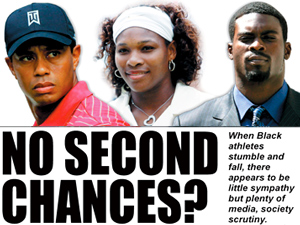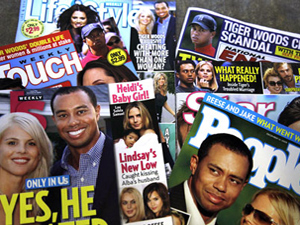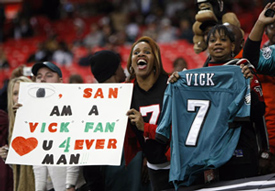Stereotypes, the media and Black athletes who get into trouble
By James G. Muhammad -Contributing Editor- | Last updated: Dec 15, 2009 - 12:28:58 PMWhat's your opinion on this article?

While the mainstream media seems to be oblivious to the perception of a double standard or that they tend to focus on Black athletes who get in trouble, a lively discussion is taking place in the blogosphere. Topics like “How would the press treat a White Michael Vick?” and “The latest example of how White athletes are being protected by ESPN” are just a few of the headlines. |
Did the names Kobe Bryant and Tiger Woods go through your mind? How about Barry Bonds?
More than likely the images and names conjured up when speaking of athletes in trouble are of Blacks and other athletes of color, not the Tom Bradys, Ben Rothlisbergers or Mark McGuires of the athletic world who work alongside the Black standouts.
Golfer Woods, who has avoided race though subjected to insults at times, is the latest Black athlete to endure public pillaring. His extramarital affairs have garnered wall to wall news coverage and major sponsors dropping him was a huge Dec. 14 news story. Instead of a portrayal of a thug, the golf and endorsement giant has been painted as morally unfit and irresponsible.
But why are the faces we see in the media in continuous and seemingly unrelenting attacks mostly of Black athletes? Are they more susceptible to moral failures, criminal activity or going afoul of the laws and rules of the leagues?
“It's not that there's a higher percentage of African American athletes who are crossing the lines than White players,” said Dr. Richard Lapchick, director of the Institute for Diversity and Ethics in Sports at the University of Central Florida. “But the media have created two perceptions—that athletes in general are more inclined to be violent against women and use drugs, and that Black athletes are more inclined to do both. And neither is true.”
Both media double standards show up whenever Dr. Lapchick is interviewed. Whether it's because of the hunger for gossip and sensational news about celebrities, athletes appear to be prominent as abusers of drugs and women, but the reality is more than four million American women are battered or sexually abused every year, he said. Over the last 14 years, about 100 athletes have been accused of such crimes, he said.

Magazines featuring Tiger Woods are photographed in New York, Dec. 2. Mr. Woods said he let his family down with “transgressions” he regrets “with all of my heart,” and that he will deal with his personal life behind closed doors, in a statement. Photo: AP Wide World Photo/Julie Jacobson
|
A glaring example of this focus on Black athletes as the face of criminal violations is a 2006 article in USA Today, Dr. Lapchick continued. The front page article might have been mistaken for a Most Wanted poster in the post office. Head shots of prominent athletes were aligned with the title “Athletes lightly punished after their day in court.” The article argued that a double standard exists in the punishment athletes receive for illegal acts compared to regular citizens—celebrity appearances and autograph signing instead of gritty details like collecting trash on the roadside. But it also exposed the blatant double standard implemented by the media in highlighting the violations of Black athletes. Seventy-five percent of those highlighted were Blacks and athletes of color.
“They could have easily found (more Whites) and made it a more integrated cover. They didn't think about it until after the mistake,” Dr. Lapchick said.
Celebrity status and tabloid scandals

Michael Vick fans react as the Philadelphia Eagles prepare for their NFL football game against the Atlanta Falcons at the Georgia Dome in Atlanta, Dec. 6. It was Vick's first game in Atlanta since his conviction on dogfighting charges. Photo: AP Wide World Photo/Dave Martin
|
Whether there is any significant difference in the celebrity status of a Kobe Bryant and Ben Roethlisberger is debatable. What's not debatable is the blanket coverage of Mr. Bryant's sex scandal compared to allegations of rape filed against Mr. Roethlisberger.
“White supremacy has recognized and demonized us as being physically and spiritually superior,” said Kansas City, Mo., clinical psychologist Dr. Harry Davidson. “The problem is that it is alright to be a superior athlete. Just don't rub it in White folks' faces.”
Black athletes are moving targets for the media because of their celebrity status and potential to marshal Black youth in more positive directions. Many of the athletes who get into trouble themselves are young and inexperienced in handling large sums of money, making them susceptible to being relieved of their money (and influence) by getting into trouble. But there are also questions about proper temperament and expectations for proper conduct: Tennis star Serena Williams was fined a record $82,500 for anger expressed at an official during a match. She is matching the fine with an equal donation through her foundation to open a school in Africa. But the volatile John McEnroe, now a commentator and a tennis star of the 1970s and 1980s, had legendary angry outbursts. In retirement, he had a commercial that played on his huge temper tantrums.
Observers note there is no real, formal process for training these young athletes, some of whom come from homes and communities already facing huge social and economic challenges. Many are passed through college programs for the huge financial benefits they bring the schools. They get to the pros and again are left to waste their fortunes and make others rich.
If a Black athlete is outspoken or becomes politically and racially conscious, they are vilified, Dr. Davidson said, pointing to historical figures such as boxers Jack Johnson and Muhammad Ali, 1968 Olympic medal winners Tommie Smith and John Carlos and football star Jim Brown. Allowing influential athletes to challenge the notion of White superiority could signal to others that it's OK to do so, he said.
“The term natural athlete is a misnomer,” Dr. Davidson continued. “The ‘Mandingo' was trained to fight the neighboring slave master's bred slave. He was a prized N [sic] who won large sums of money for his master. Modern Black athletes are the descendants of bred and conditioned field slaves.
“They get in trouble for speaking out, getting out of their place, while being honored and even worshipped for their physical prowess,” he said.
An example of a Black athlete who was cut off at the knees because he wanted to stand up is former Chicago Bulls star Craig Hodges, one of only two players in history to win three consecutive All Star 3-Point shooting contests. He made no secret of his friendship with the Honorable Minister Louis Farrakhan and challenged fellow Black athletes to do more for their community. The proverbial straw that broke the camel's back was when the Bulls won their second consecutive NBA championship in 1992 and Hodges wore a dashiki during the traditional visit to the White House for the NBA champions. He also reportedly gave President George H.W. Bush a letter asking him to address the ills of the Black community.
Outspoken players punished?
With the excuse that the 32-year-old Hodges was a weak defensive player, the Bulls let him go the next season and no other team even offered him a tryout.
Would the same have happened to a Jewish player who showed up wearing a yarmulke and handed the president a letter asking for support of Israel, or an Irish player who showed up in kilts and asked for recognition of Irish Americans' past struggles? What Hodges did say, according to a 2008 story by ESPN writer L.Z. Granderson, is:
“I was outspoken, but I wasn't disrespectful. I was never in trouble for drugs, or guns or raping women or anything like that. I just wanted to help my community, and that made me a troublemaker. I went from making $600,000 a year to making nothing. No one would take my calls; no one would give me a chance. I went from helping a team win it all to all of a sudden not being good enough to play for the worst team in the league,” Mr. Hodges said.
But even athletes like Terrell Owens, who did nothing illegal, still can be vilified in the media. As he says, “They still love to hate me.”
There's a reason for that, according to Dr. Michael D. Giardina, visiting assistant professor of Advertising & Cultural Studies at the University of Illinois, Urbana-Champaign, and a writer for such scholarly publications as the Journal of Sport and Social Issues.
Much of football player Owens' reputation of being a jerk is tied to his public disagreements with star Philadelphia Eagles quarterback Donovan McNabb and his criticisms of Dallas Cowboys quarterbacks prior to Tony Romo's arrival, he said. These complaints were amplified by how they were reported by the media.
“So we have the actual things Owens has done, and the way they are reported. In an age when the mainstream press tends to be more infotainment than real journalism, stories about Owens feed into a ready-made narrative of the ‘trouble-maker.' It does not help his case that his relationship with the media, much like, for instance, Barry Bonds, is at times adversarial,” he said.
While the mainstream media seems to be oblivious to the perception of a double standard or that they tend to focus on Black athletes who get in trouble, a lively discussion is taking place in the blogosphere. Topics like “How would the press treat a White Michael Vick?” and “The latest example of how White athletes are being protected by ESPN” are just a few of the headlines.
Calling on Black athletes to step up but at the same time pulling the curtains back on mainstream media's demonizing of Black athletes, one blogger wrote: “If you keep messing up without accountability and putting your team, your family and more importantly yourselves on blast then you should expect outlets like ESPN—who is complicit in exacerbating the negative imagery of Black men while White athletes, coaches and administrators skate—will make sure your ghetto mug shot is plastered all over the damn place.”
Dr. Boyce Watkins, a social commentator and professor at Syracuse University, said Black athletes are starting from behind the 8-ball to begin with as a result of the value systems built on 400 years of White supremacy. Most people are involuntary supporters of this racist infrastructure and force these values on others in the society, he said.
As a result, “it doesn't matter if Terrell Owens is a good or bad person, what matters is what White America thinks of him,” he said.
“If (journalists, team owners or fans) subscribe to the value system of most White Americans, they're going to hate T.O., not because he's Black, but because he's different. But, ultimately, the fact that they hate him because he's different means they hate him because he's Black. Their value systems are so correlated along racial lines to begin with,” he said.
Dr. Watkins said the mainstream media could play an important role balancing the image of Black athletes and at the same time impact the behavior of Black youth. When then-Senator Barack Obama was running for president of the United States, the grades of Black boys went up as a result of seeing Mr. Obama regularly in the media, said Dr. Watkins, who also is affiliated with the College Sports Research Institute at University of North Carolina, Chapel Hill.
“The media plays a major role in perceptions because they decide who the cameras should be pointed at. They can help fix the problem by focusing on positive Black behavior as well,” he said.
Dr. Watkins said Black athletes must learn how to manage their money, get education in order to understand how to use the power they have and set high expectations for themselves as athletes.
“You are more than just a basketball or football player. You are a leader and meant for a higher purpose in our society. There is a role for you when it comes to the uplift of your people. Don't buy into the idea that you are supposed to simply be a tool for corporate America. Expect more from yourself,” he said.
Related news:
To Be Honest, I Believe I Reached My Boiling Point (Serena Williams' Blog)
INSIDE STORIES AND REVIEWS
-
-
About Harriett ... and the Negro Hollywood Road Show
By Rabiah Muhammad, Guest Columnist » Full Story -
Skepticism greets Jay-Z, NFL talk of inspiring change
By Bryan 18X Crawford and Richard B. Muhammad The Final Call Newspaper @TheFinalCall » Full Story -
The painful problem of Black girls and suicide
By Charlene Muhammad -National Correspondent- » Full Story -
Exploitation of Innocence - Report: Perceptions, policies hurting Black girls
By Charlene Muhammad -National Correspondent- » Full Story -
Big Ballin: Big ideas fuel a father’s Big Baller Brand and brash business sense
By Bryan Crawford -Contributing Writer- » Full Story






 Click Here Stay Connected!
Click Here Stay Connected!








